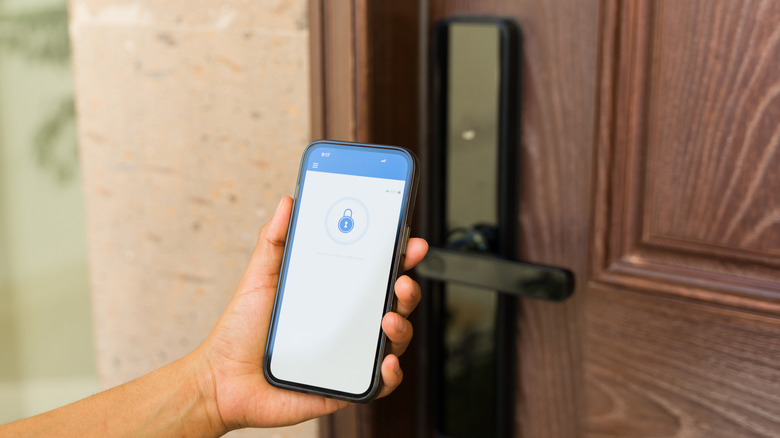Why Your Keyless Digital Door Lock Has Locked You Out (Or Won't Respond)
It's amazing how few things are considered unacceptable. People will live in places that might be covered up with water, burned down with wildfire, or pitched over into the sea at any moment. But a lock that doesn't work is a bridge too far for just about everyone. And it should be. When you try to get into your home and can't, it's a safety risk for reasons you can (and should only have to) imagine. Also, it's pretty annoying, and the reasons it happens — batteries, connectivity, and simple wear, or even a lock getting jammed the same way an old-fashion lock jams – don't make it less annoying.
Keyless, keypad, and biometric locks are a convenience right up to the moment they're not. If your locks are failing for reasons you can't seem to prevent, it might be time to consider different keyless locks, or jettisoning the whole keyless thing completely. They're not for everyone, and as the technology evolves, they seem to become less and less for everyone. Even in the very best case, they don't do much to improve security unless they're part of a larger security or smart home system.
We have seen reports of people getting locked inside their homes because of lock failures. Our advice would be to not use a lock system that prevents you from exiting your premises without relying on code entry or any other electronically actuated mechanism. Not being able to get in your home is a safety issue, not being able to get out is an extreme and utterly unacceptable safety emergency. That said, let's look into why this awful situation happens in the first place.
Why you get locked out
Sometimes keyless lock failures require a little look in the mirror. The most common reason you end up standing in your driveway (yelling at some poor lock tech support person on the phone) is that your batteries have given up. As small as the energy requirements might be, remember that the batteries have to move a physical actuator in order to secure your door. Connected locks monitor battery levels and alert you when one is getting low... but is anything easier to ignore than a notification on your phone? And occasionally you'll simply forget an infrequently used access code.
There are technical reasons locks fail, as well as physical causes. Locks have a lot of critical parts, after all. Wear, dirt, moisture, weather (especially cold), and other factors can cause the moving parts to freeze, misalign, come loose, or otherwise become uncooperative. Cleaning and lubricating according to manufacturer's instructions can help with this, of course. The more vexing technical problems have to do with connectivity, particularly with Wi-Fi and Bluetooth-connected locks. Network interruptions, weak Wi-Fi or Bluetooth signals, or compatibility issues with either technology can make it impossible to communicate with the lock via your mobile device.
Dealing with connectivity and other technical glitches starts with the old standby: Reboot. If your lock has one, use a backup physical key or a one-time PIN. Next, try resetting the lock, which usually requires completely re-programming the lock, including any additional codes you might have added for family members, contractors, etc. Beyond that, you're pretty much reduced to customer support or a locksmith. Or learn to pick a deadbolt lock.

